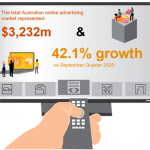Social advertising spend grew by 26.2% year-on-year in the first three months of 2019 to a total of $17.9 billion worldwide, and while this is the second-highest total in the format’s relatively young history, it was roughly half the growth seen last year and key players are now looking to diversify their revenue streams.
This is according to WARC’s latest Global Advertising Trends, which takes a deep dive into the figures for the six most visible social media companies from across the world – Facebook, Pinterest, Snap, Twitter, Tencent (WeChat/QQ), and Weibo. All reported an easing in ad revenue growth in Q1 2019.
“The social sector is still expanding at a rapid pace – amassing $17.9bn of ad money in the first three months of this year alone – but growth has eased over recent quarters and has halved from a year ago,” says James McDonald, Managing Editor, WARC Data.

In its largest and most saturated market of North America, where $8 billion was spent in Q1 2019 alone, user growth has stalled and consumer trust in social platforms is waning, McDonald adds.
Meanwhile, time spent on social platforms hasn’t increased for the last three years, with users maintaining a two hour per day average since 2016. Across the continent, Facebook has 186m daily users, Snap 80m, and Twitter 28m – numbers that are mostly flat or down from the previous year.
In Europe, growth across all of Facebook’s social properties (which include Instagram and the wildly popular WhatsApp) slowed to its lowest rate on record: +1.4%. Across all platforms a similar picture emerges: according to GlobalWebIndex, daily social media usage has fallen by four minutes versus the previous year to one hour and 49 minutes. For its part, Snap saw user numbers fall for the first time in the region.

Richer growth is coming from Asia, with India a particularly strong grower alongside Indonesia and the Philippines.
Daily social usage is climbing: in 2019, daily use across the region reached 2:11, compared to 2:09 last year. There’s an important caveat, however, that monetisation in the region is far lower than in Western markets.
The slowdown in social ad growth comes at the same time as the tech sector is under pressure over its use of consumer data.
Recent research by YouGov, Dentsu and Universal McCann, among others, finds that half of consumers believe tech and social media companies have too much power and influence. A similar proportion want to see more regulation of the industry.
But the trust deficit has layers. As many as two-thirds of consumers don’t trust the information that comes from social media, with rates as high as 82% in Great Britain and 70% in the US.
As many as three-quarters of consumers now limit their online footprint, citing the misuse of personal data as the biggest cause of distrust.

Social platforms are reacting, McDonald observes. “Facebook is looking to diversify its revenue streams with the launch of Libra which, the company says, will not be used directly to enrich the consumer data it has harvested for ad selling purposes.
“However, the cost of advertising on Facebook’s social platforms could feasibly rise if the company proves a relationship between the ads it serves and an increase in Libra-facilitated sales.”
While social shopping is still nascent on Western platforms, in China, the ease of mobile payment has made social shopping a norm.
Tencent made RMB21.8bn ($3.2bn) from FinTech in the first three months of this year. In the US, meanwhile, concerns around security and privacy are hampering the growth of social commerce.
Source: WARC
MARKETING Magazine is not responsible for the content of external sites.
An afternoon of conversations we never had, with leaders most of you never met.
Discover what’s possible from those who made it possible. Plus a preview of The HAM Agency Rankings REPORT 2024.
Limited seats: [email protected]
BOOK SEATS NOW









